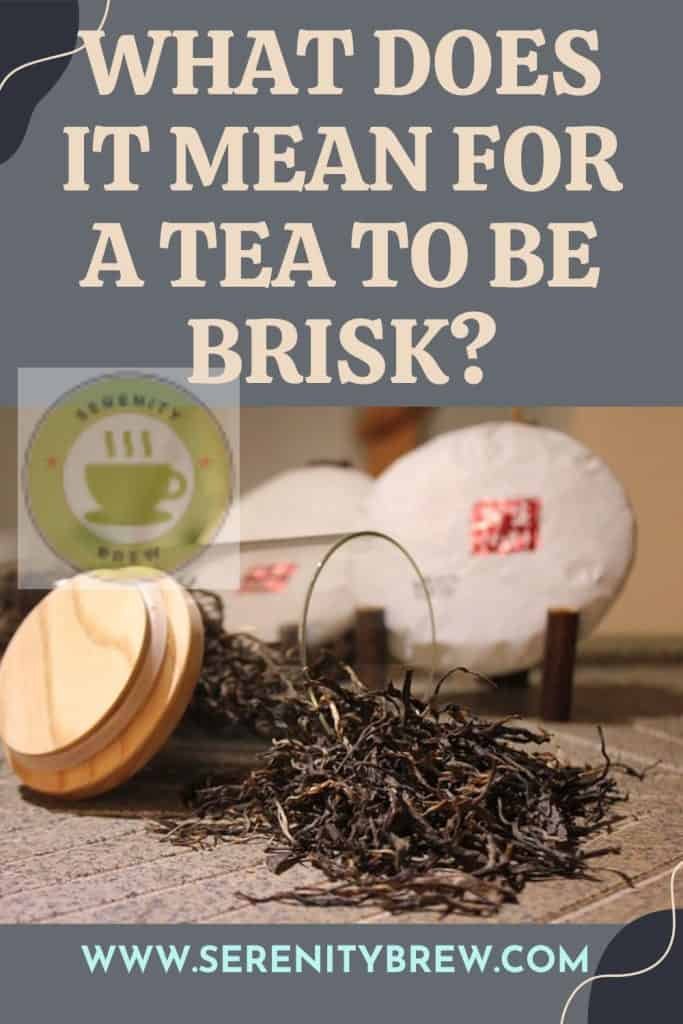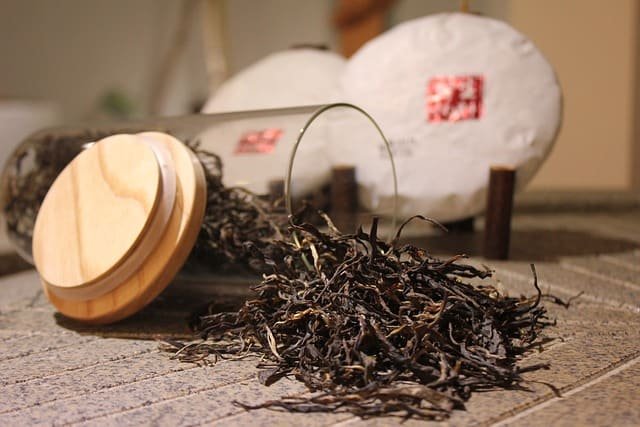
We answered a Quora question about what it means for a tea to not be brisk, which we’ll convert into the opposite: A summary of what “briskness” in tea actually means. To me, it either means bright in flavor and character or else astringent (possessing a mouth-feel) in such a way that is appealing or having a feel that is sharp in a particular positive way. To me the latter is really the core meaning. Could the two overlap? Sure; we’ll get to that.
Briskness and Astringency
A particular feel range does tend to pair with a general flavor and character intensity or, rather, multiple variations of both tend to correspond in different tea types and forms. As you experience a slight sharpness in mouthfeel—not harshness, which would be a flaw—you also tend to experience a brightness or intensity in flavor range. It’s not as if they have to be combined, but it tends to work out like that. We are probably mostly talking about black tea, which will be implied in a lot of the following; but more explicit in certain ways related to the cause. After talking through some basic meaning and experience range related to types, this will get to root causes and compounds causing related effects.
Green tea often possesses a very different but typical astringency (feel), but to ask about an oolong being brisk makes no sense. Oolong is a broad category that varies quite a bit in range, but versions tend to be full in feel – rich or even creamy. Some contain an astringency that’s different than in black teas, but how that works out—and related to what inputs—and how positive that is, is all a bit complicated to add as a tangent. The main types of oolongs, Tie Guan Yin, Wuyi Yancha, Dan Cong, Taiwanese high mountain rolled oolongs, and Oriental Beauty, are all not particularly rough in feel/astringent. Only off-area Guangdong oolongs we’ve tried are like that, which we won’t go further into here.
A black tea that isn’t brisk might just relate to a different style of black tea not being like that. Yunnan-style black tea, Dian Hong, or a related sun-dried variation of those, Shai Hong, are not brisk. The form of astringency is different and the set of typical flavors. So we’re now down to talking conventional black teas like those from Assam and Sri Lanka, with typical Assam character including more of that range. Darjeeling can even fall by the wayside a bit – for lots of those being oxidized to different levels, aspect range tends to vary and what we often mean by a positive “briskness” input doesn’t tend to apply.
Whole leaf tea in general possesses far different astringency character than ground up or broken black tea. Flavor range aspects vary too, not in such a narrow set of ways that it’s easy to map it all out. I just drank a very pleasant Georgian black tea for a review and in one sense it wasn’t brisk; astringency was moderate. But flavors were quite distinct and intense, so if someone was using the terms in a different way than we do they might judge it differently.
Briskness Definitions
One last aside before getting to more direct cause inputs: How could there be differences in how a basic description term is used for tea? Aspects tend to adjoin and mix, and then without a centralized form of definitions other usage variation can creep in. Here’s a standard simple definition from a main commercial vendor, Harney and Sons:
“Briskness – Refers to a tea’s ability to make your mouth pucker, also known as astringency.”
So for them it just means astringency. We take that to be right, but common usage also implies connection to other tea character, even though it’s really a different aspect range (eg. flavor intensity or certain flavor range).
Let’s consider if a specialized use of the term couldn’t have evolved within a research context in India:
“The major quality parameters that are tested in made tea include Theaflavins (TF), Thearubigins (TR), High polymerized substances (HPS), Total liquor color (TLC) and Total soluble solids (Water extract). TF has a direct correlation with quality and price realization. TF contribute towards the briskness and brightness of tea liquor…
In addition to the above quality parameters briskness and color indices developed at UPASI TRI, correlate well with quality of made tea. Briskness index is given as percent ratio of TF to TF+CAF and the normal range for south Indian CTC tea is above 23.”
Theaflavins and thearubigins are complex compounds found in black teas, outputs of an oxidation process as other types of complex compounds are converted to those. This Tea Epicure site reference covers all of the main types of compounds found in tea, and more on those in particular: Chemical Compounds in Tea –
“There are several known categories within polyphenols. Flavonoids are arguably the most important category; they are the reason for many health claims surrounding tea because they contain antioxidants.
Within the flavonoid group are flavanols, flavonols, flavones, isoflavones, and anthocyanins. Flavanols (short for flavan-3-ols) are the most prevalent and thus the most studied. Flavanols are often referred to as tannins or catechins. The major flavanols in tea are: catechin (C), epicatechin (EC), epicatechin gallate (ECG), gallocatechin (GC), epigallocatechin (EGC), and epigallocatechin gallate (EGCG). EGCG is the most active of the catechins, and this flavanol is often the subject of studies regarding tea antioxidants.
Flavanols are converted to theaflavins and thearubigins during oxidation. They are the compounds responsible for the dark color and robust flavors that are present in oxidized teas.”
The reference to color, flavor, and feel (implied in explaining that these are what is referred to as “tannins”) starts in on unpacking why it’s a good thing that certain feel range increases, because flavor range also does. People tend not to value certain colors in tea without training or experience in associating them with other experience, but that links too.
Briskness in Recently Reviewed Teas

So, heading towards a conclusion, there are two types of discussions about the positive level and role of briskness depending on the tea type, origin, presentation form (chopped vs. whole leaf), and related to varying use of terms. Describing a tea as brisk or not has two completely different meanings, depending on whether that’s an expected positive input range in the first place. For CTC (ground up leaf) black tea Assam a version had better be brisk (astringent in a particular sense, to a particular expected level), and for Chinese or Taiwanese whole leaf black teas in general they’re just not, because levels of related compounds are moderate, by design.
Astringency still plays a very important role in judging the quality of those teas, and the role and form is comparable. A black tea lacking astringency, in the different sense of fullness and structure, wouldn’t be as positive. It’s just that very positive versions of such teas wouldn’t be described as brisk, because astringency and related compounds are much more moderate and probably quite different in proportion; at least in relation to those providing the most feel-edge/rough feel.
If further reading on types to clarify this are of interest, we reviewed a very pleasant Chinese black tea recently (that I wouldn’t describe as brisk) with a lot of detailed commentary about feel range: Wuyi Origin Wuyishan benefit black tea.
Just to offset this seemingly-biased towards Chinese versus Indian teas we also reviewed two fantastic, very well-regarded Darjeeling second flush black tea versions this month, with very comparable observations: Arya Ruby and Giddapahar Second Flush Darjeelings.
We wouldn’t describe any of those three teas I’ve just mentioned as brisk, but the mouthfeel properties in all three are different. To me, a brisk tea balances on the edge of being rough in feel and intense in warm flavor range, towards aromatic wood tones without going far enough that it seems better to add milk to delete out that effect. CTC teas—ground black tea versions—tend to cross that divide, and be more positive drunk with milk added, and I suppose good plantation-origin Assam is an example of what is right at that edge. Really good orthodox Assam tends to be more like Chinese black tea, full in feel but smoother yet in character, with this main plantation Halmari version back at the slightly rougher edge but still balancing it well.
Again a Chinese black tea drinker, mainly, also open to Darjeeling and Nepal versions in different styles that are comparable in quality, so not seeking out the more intense but rougher range of experience right at that edge. Trying a more brisk black tea could be interesting but with almost never experiencing what interpret as in that range. And mostly drink sheng pu’er, which is very diverse related to complex mouthfeel range, but in a different set of ways that wouldn’t be described as briskness.
